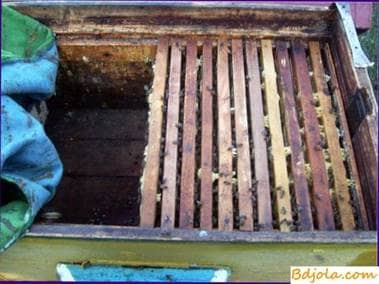Assembling the nests for the winter

In natural conditions in hollows and caves, bees build honeycombs and have fodder reserves so that in winter they are easily accessible to them.
The frame hive makes it difficult for bees to migrate from one honeycomb to another in the winter with insufficient honey. Besides, the nest of bees during the season repeatedly and sometimes senselessly breaks the beekeeper himself: examining families, changing frames, moving gate valves, etc. In order that bees in winter do not die of hunger, one must be able to properly assemble a nest.
The number of frames left in the nest should correspond to the strength of the family, that is, all frames must be completely occupied by bees. When hibernating bees in a warm room, it is allowed to leave in the nest 1-2 shelter frames that are not surrounded by bees.
It is noticed that with compressed nests the frame is not moldy and there is no loss of bees from the cold on extreme limits. Bees better winter on dark honeycombs: these honeycombs are warmer, but since they need to be removed in spring, they put them from the edges of the nest, and in the center, where the brood appears early, leave light brown. At the bottom of each frame there should be empty cells, into which the bees climb, forming a denser club. The absence of a bed from empty cells in the nest worsens the hibernation of bees and weakens them.
Some beekeepers practice assembling nests on extended streets. Do not do this, as for a large number of accumulated bees may not have enough food, which will complicate their wintering.
When assembling the nests, make sure that in the middle of the nest there is no piercing frame, sealed over a small amount of honey. When viewing the light, such a frame does not shine through, as there is little honey in it, the bees will quickly eat it, the bees will die of hunger or the family will be separated into 2 clubs, which will complicate
For many years, when assembling the nests of bees, we do not put the frames close to the southern wall of the hive, but leave the lumen on one frame and remove the diaphragm. In this case, the bees are better than winter, and the frame is not moldy.
Collecting the nest, we must bear in mind that the last brood and club of bees will form against the tap. Eating honey, the club of bees gradually rises. Approximately 2 kg of honey in the street is enough for bees to feed and breed brood in winter and early spring. With less honey in the street, bees may not be enough for it and they will have to move to the next frame. In the cold and small power of the family, they do not always succeed. As a result, bees die of hunger, although honey remains in the hive.
To ensure the transition of bees to other streets on top of the frame put brusochki or in honeycomb pierced passages. However, this requires proper assembly of the nest, otherwise all efforts will be in vain.
When honey bees are provided within 20 kg of the nest assembly passes quickly, it reduces only to the removal of several light and small-framed frames that have been freed from brood. In some cases, the frame with the brood at the output is transferred to the edge of the socket for a more convenient subsequent removal. Therefore, hurry with the assembly of nests with sufficient forage reserves should not be. The nest is harvested when the brood is almost all come out. The last exit from the brood cells depends on the availability of supporting honey, the age of the uterus, the breed of bees and other causes.
In strong families, with sufficient forage reserves, the nest is collected in a bilateral way. In the middle of the nest, frames of 1.8-2 kg are placed with a gradual increase in their mass to the edges of the nest. In what direction the club of bees will move, they will have enough forage till the spring. If several frames with a reserve of honey less than 1.8 kg are left in the nest, the bees are given sugar top dressing so that they replenish the low-copper frames.
If there is not enough honey in the nest, apply one-sided placement of fodder stocks (angle). On the southern side of the nest they put the most full honey frame, behind it 1-2 frames of 1.5-1.8 kg, then put frames on a growing mass, so that there are 15-17 kg of honey in the nest.
With small fodder reserves (8-12 kg) honey is placed “beard”. In the center of the nest against the tap, the heaviest frame is placed. On the sides of it, the remaining frames are placed with a gradual decrease from the mass. No matter where the bees are, they will move to the center of the nest, and they will have enough honey until the spring.

Bee families who will exhibit in winter greenhouses, should not be fed a lot of sugar syrup in order to avoid “wear” of bees. Forage stocks are replenished in the greenhouse by the setting of honey in honeycombs.
Easier to gather nests in multi-hulls. If bees are left to winter in 2 buildings, the preparation of bees for wintering is reduced to placing a prefabricated body with printed honey on the body occupied by bees, brood and a small amount of honey. If the bees will be wintering in the cold, it is important that the dry land within the 2nd building be completely rebuilt to the bottom bar. This is necessary for a more dense placement of bees and facilitating their transition to the main stocks of feed.
Assembling the nests for the winter
